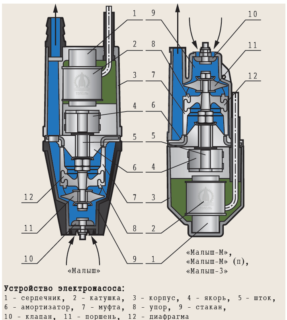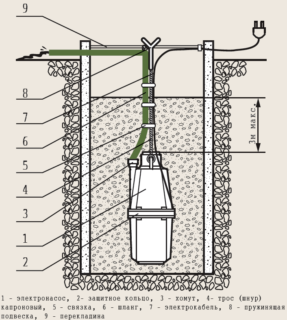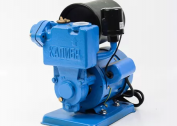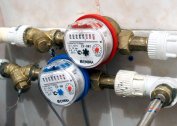Well construction involves the use of a production pump. With its help, it is possible to raise water from great depths, constantly maintain optimal pressure in the pipeline. Among masters, the use of submersible vibration pumps for wells is common. Their technical characteristics are optimal for any source.
Purpose and scope of vibrating well pumps
Using a vibrating submersible pump, they raise the liquid medium from a depth of 20-30 meters and successfully transport it along the highway. Use such units in the following cases:
- rise of water from a well, well;
- pumping a source just drilled;
- drainage of a well, a well with a small flow rate for inspection of the bottom and its cleaning;
- filling storage tanks with water and returning fluid from them (watering, car washing, etc.);
- liquid intake from natural sources in the country (pond, lake, river) for irrigation of garden lands;
- drainage of flooded premises (basement, cellar).
With proper operation, the submersible vibration pump lasts 10 years.
Advantages and disadvantages
A vibrating unit is characterized by both advantages and disadvantages. The first include:
- relatively reasonable price;
- wide range - you can choose devices of domestic or foreign manufacturer;
- low noise level;
- optimal performance;
- the ability to lift water from great depths;
- ease of installation, connection.
The disadvantages of vibration downhole pumps include:
- Lack of thermal protection for some models. Without it, on dry run, the unit will work no more than 10 seconds. After this, the winding will burn.
- Regular untwisting of threaded joints when exposed to vibration. The issue is solved by replacing the nuts with self-locking nuts.
- Exposure to corrosion bolts. Even the zinc coating wears off over time, which leads to the formation of rust on the fasteners.
- Wear of rubber elements under the influence of abrasive particles of sand in water, especially if the well is made of limestone or sand formation.
- Sensitivity to voltage drops in the network. For example, if the current decreases by only 15%, the pump performance drops almost twice.
The vibration pump eventually destroys the walls of the concrete casing. The problem can be solved with the help of a dense rubber ring, which is put on the sleeve of the device in its widest part during installation.
Types, principle of operation and device
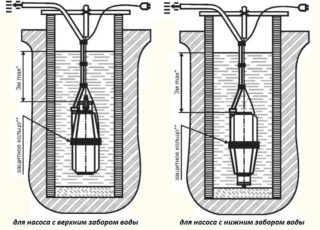 In total, two types of vibration pumps are distinguished:
In total, two types of vibration pumps are distinguished:
- With top water intake. The inlet pipe is located on top. Models have a long service life due to the fact that small debris at the bottom of the source (sand, clay) does not fall into the device’s chamber. Additionally, the water flowing through the upper partbok cools the electrical components of the unit. But the minus of the pump with the upper liquid intake is that when the water mirror falls in the well, the device idles. It is advisable to use devices with an upper fence for sources with intensely dirty water and at a constant flow rate.
- With bottom water intake. The models are good in that they can supply fluid from almost the bottom of the source. Therefore, pumps with a lower intake are especially good for wells with unstable flow rates. But here it is worth monitoring the level of contamination of the bottom. If the source is very sandy, a rough filter cannot be dispensed with. Otherwise, the garbage will quickly disable the pump.
All models of vibrational models are arranged almost identically. The only difference is the location of the incoming pipe. The main working elements of the vibrating device:
- working chambers;
- membrane;
- vibration device.
Well units work like this:
- When the pump is turned on, an electric current enters the winding. It creates a magnetic field that attracts a vibrating device.
- The diaphragm (membrane) bends towards the storage chamber and draws water into it. This happens due to the resulting vacuum in the suction chamber.
- As soon as it is filled, the pressure rises again and the water overflows with the help of a piston, which presses it up. She goes into the pipes and further into the highway.
Magnetization / demagnetization cycles are repeated continuously (more than 100 times / sec.). This ensures the continuous operation of the vibration pump.
How to choose a vibrating pump
The purchase of a downhole vibrating device is always based on the following criteria:
- Pump performance. It should not be higher than the flow rate of the well, otherwise it will be drained.
- The power of the device.
- Desired head pressure. It is calculated by the distance from the well to the farthest sanitary point of the house.
- Casing diameter and source depth.
It is desirable to mount a submersible pump with a lower fence at least a meter from the bottom of the well.
Principles of installation, connection
To install the vibration unit, you need to prepare:
- Water hoses (intake and supply). Their cross section must be at least 18 mm.
- Fittings for connecting hoses to a pump.
- Coarse filter plus check valve.
- Safety cable. It is advisable to take not a steel, but a dense kapron.
- Rubber ring on the sleeve of the device.
- Clamps or at least construction tape.
The assembly and installation of the system is as follows:
- On one side, an inlet hose is attached to the inlet pipe with fittings. A coarse filter is immediately mounted on its end.
- The second part of the hose (supply) is mounted to the outlet pipe. A check valve must be installed on it.
- A safety cord is attached to the eyes of the pump. Thus, three components should stretch from the unit - a cable, a water supply hose, an electric cable. To avoid their sagging in the well, it is better to tighten all three elements with clamps or tape. Avoid strong tension of each of them. The spacing of the clamps is 50-70 cm. The first connection is best done 20 cm from the pump sleeve.
- A dense rubber ring is put on the body of the unit.
- The pump is lowered to a predetermined depth.
- Across the casing, you can lay the bar to which the safety cable will be fixed.
- Connect the device to the network.
With a protection class of 1 unit, the outlet must be earthed.
Features of operation and maintenance
For proper operation of a submersible vibration pump, you must adhere to the following recommendations:
- it is forbidden to use equipment with a damaged power cable;
- if the pump is running, do not shut off the water supply;
- permissible continuous operation of the equipment - no more than 2 hours;
- if the unit is not used in winter, it is lifted from the well, dried, lubricated with fasteners and put away in a dry place for storage.
To use the device in the winter, a small hole of 1.5 cm is made in the hose next to its body. It helps protect the pump from freezing and provides free outflow of water. In summer, the hole can be covered with electrical tape.
